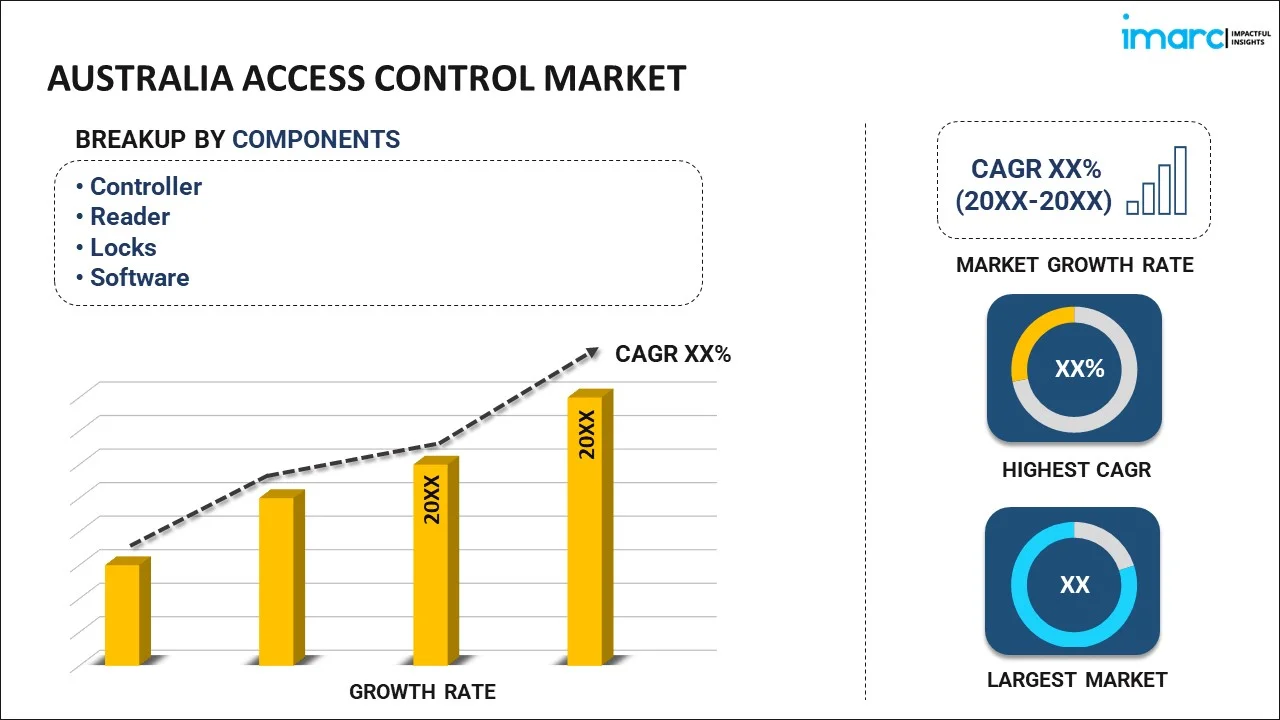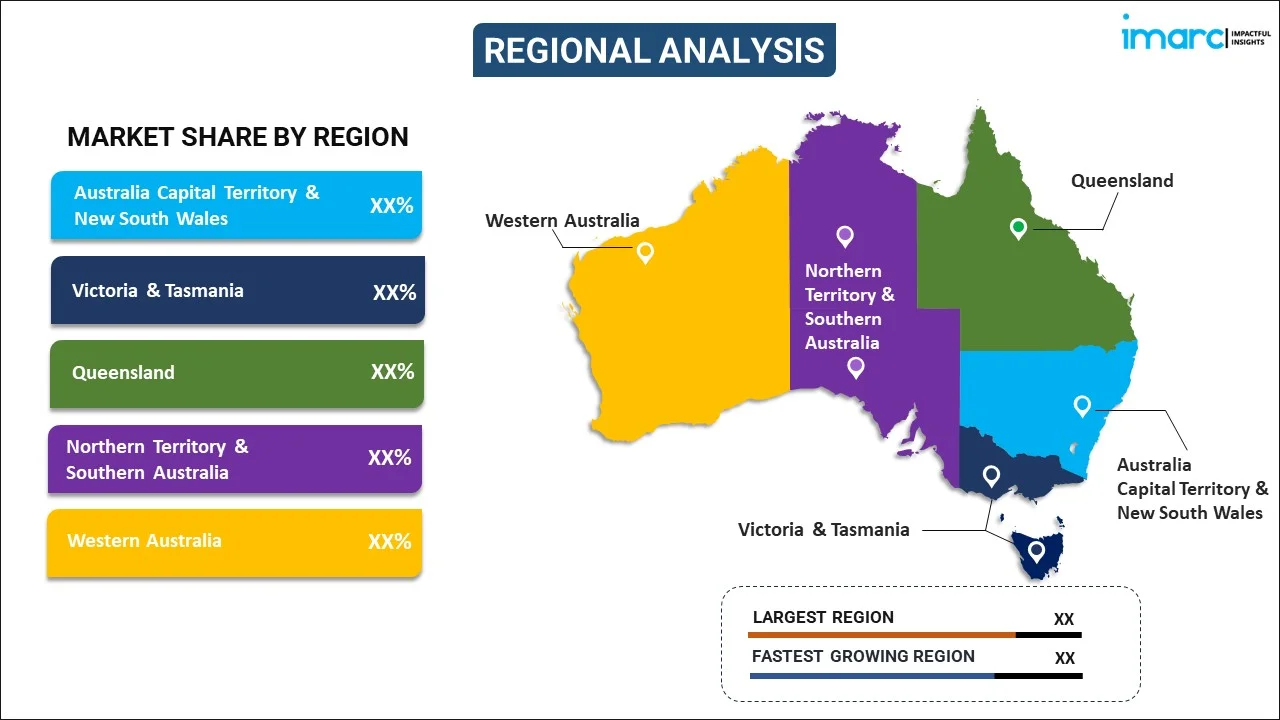
Australia Access Control Market Report by Component (Controller, Reader, Locks, Software), Type (Card-based, Biometric-based), End User (Government, Military and Defense, Commercial, Healthcare, Manufacturing, Transport, Education, Residential, and Others), and Region 2025-2033
Market Overview:
Australia access control market size is projected to exhibit a growth rate (CAGR) of 7.89% during 2025-2033. The inflating popularity of biometric authentication systems and the rising security concerns among businesses are primarily propelling the market growth across the country.
|
Report Attribute
|
Key Statistics
|
|---|---|
|
Base Year
|
2024 |
|
Forecast Years
|
2025-2033 |
|
Historical Years
|
2019-2024
|
| Market Growth Rate (2025-2033) | 7.89% |
Access control is a security method developed to safeguard both physical and virtual assets, ensuring that only approved individuals or entities can enter specific systems, devices, or facilities. Various methods, encompassing physical barriers like doors, locks, fences, etc., alongside electronic systems, such as biometric scanners, smart cards, and passwords, are employed to implement access control. These systems typically comprise components like an access control server, a roster of authorized users, hardware like card readers or biometric scanners, etc. During an attempt to access a secure area, credentials undergo verification against the authorized user database. Notably, access control also finds extensive applications in residential and commercial buildings, where it is utilized to regulate entry to specific areas or facilities. This evolution underscores its growing significance in diverse contexts beyond traditional security domains. Consequently, it is gaining traction across the country.
Australia Access Control Market Trends:
The Australia access control market is experiencing significant growth, driven by the growing consciousness among individuals towards security measures in both physical and virtual spaces. Moreover, technological advancements play a pivotal role in shaping the landscape of the access control market across the country. Besides this, the elevating integration of enhanced electronic systems, such as biometric scanners and smart cards, to improve the efficacy of access control measures is further bolstering the market growth. Additionally, the diversification of applications for access control systems is contributing to the market expansion. Beyond traditional uses, access control is gaining traction in residential and commercial buildings, where it is employed to regulate entry to specific areas and facilities. Furthermore, the increasing regulatory emphasis on data protection and privacy is compelling businesses to invest in robust access control solutions. Moreover, compliance with stringent regulations is driving the adoption of advanced systems that offer secure and auditable access management. This, in turn, is anticipated to fuel the Australia access control market over the forecasted period.
Australia Access Control Market Segmentation:
IMARC Group provides an analysis of the key trends in each segment of the market, along with forecasts at the country level for 2025-2033. Our report has categorized the market based on component, type, and end user.
Component Insights:

- Controller
- Reader
- Locks
- Software
The report has provided a detailed breakup and analysis of the market based on the component. This includes controller, reader, locks, and software.
Type Insights:
- Card-based
- Contact
- Contactless
- Biometric-based
- Fingerprint
- Face Recognition
- Face Recognition and Fingerprint
- Iris Recognition
- Others
A detailed breakup and analysis of the market based on the type have also been provided in the report. This includes card-based (contact and contactless) and biometric-based (fingerprint, face recognition, face recognition and fingerprint, iris recognition, and others).
End User Insights:
- Government
- Military and Defense
- Commercial
- Healthcare
- Manufacturing
- Transport
- Education
- Residential
- Others
The report has provided a detailed breakup and analysis of the market based on the end user. This includes government, military and defense, commercial, healthcare, manufacturing, transport, education, residential, and others.
Regional Insights:

- Australia Capital Territory & New South Wales
- Victoria & Tasmania
- Queensland
- Northern Territory & Southern Australia
- Western Australia
The report has also provided a comprehensive analysis of all the major regional markets, which include Australia Capital Territory & New South Wales, Victoria & Tasmania, Queensland, Northern Territory & Southern Australia, and Western Australia.
Competitive Landscape:
The market research report has also provided a comprehensive analysis of the competitive landscape in the market. Competitive analysis such as market structure, key player positioning, top winning strategies, competitive dashboard, and company evaluation quadrant has been covered in the report. Also, detailed profiles of all major companies have been provided.
Australia Access Control Market Report Coverage:
| Report Features | Details |
|---|---|
| Base Year of the Analysis | 2024 |
| Historical Period | 2019-2024 |
| Forecast Period | 2025-2033 |
| Units | Million USD |
| Scope of the Report | Exploration of Historical Trends and Market Outlook, Industry Catalysts and Challenges, Segment-Wise Historical and Future Market Assessment:
|
| Components Covered | Controller, Reader, Locks, Software |
| Types Covered |
|
| End Users Covered | Government, Military and Defense, Commercial, Healthcare, Manufacturing, Transport, Education, Residential, Others |
| Regions Covered | Australia Capital Territory & New South Wales, Victoria & Tasmania, Queensland, Northern Territory & Southern Australia, Western Australia |
| Customization Scope | 10% Free Customization |
| Post-Sale Analyst Support | 10-12 Weeks |
| Delivery Format | PDF and Excel through Email (We can also provide the editable version of the report in PPT/Word format on special request) |
Key Questions Answered in This Report:
- How has the Australia access control market performed so far and how will it perform in the coming years?
- What has been the impact of COVID-19 on the Australia access control market?
- What is the breakup of the Australia access control market on the basis of component?
- What is the breakup of the Australia access control market on the basis of type?
- What is the breakup of the Australia access control market on the basis of end user?
- What are the various stages in the value chain of the Australia access control market?
- What are the key driving factors and challenges in the Australia access control?
- What is the structure of the Australia access control market and who are the key players?
- What is the degree of competition in the Australia access control market?
Key Benefits for Stakeholders:
- IMARC’s industry report offers a comprehensive quantitative analysis of various market segments, historical and current market trends, market forecasts, and dynamics of the Australia access control market from 2019-2033.
- The research report provides the latest information on the market drivers, challenges, and opportunities in the Australia access control market.
- Porter's five forces analysis assist stakeholders in assessing the impact of new entrants, competitive rivalry, supplier power, buyer power, and the threat of substitution. It helps stakeholders to analyze the level of competition within the Australia access control industry and its attractiveness.
- Competitive landscape allows stakeholders to understand their competitive environment and provides an insight into the current positions of key players in the market.
Need more help?
- Speak to our experienced analysts for insights on the current market scenarios.
- Include additional segments and countries to customize the report as per your requirement.
- Gain an unparalleled competitive advantage in your domain by understanding how to utilize the report and positively impacting your operations and revenue.
- For further assistance, please connect with our analysts.
 Inquire Before Buying
Inquire Before Buying
 Speak to an Analyst
Speak to an Analyst
 Request Brochure
Request Brochure
 Request Customization
Request Customization




.webp)




.webp)












